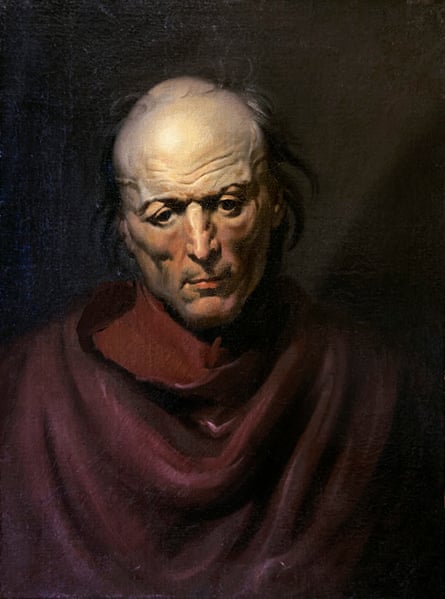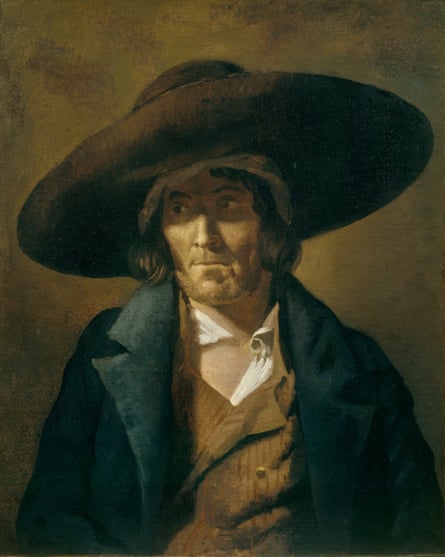[ad_1]
ohOn a hot summer night in 2018, Javier Burgos stayed up late in front of his computer. His wife and daughters were already asleep when he decided to do another round of Google searches. This time, the biologist’s quest to solve a centuries-old artistic enigma led him to a 2013 exhibition in Ravenna. Italy.
Burgos was boredly watching the first seconds of a video of the show when something caught his attention. When he stopped the video, the still image showed a museum wall with two portraits hanging on it. He recognized one of them, a 19th-century painting called Le Medecin Chef de l’Asile de Bouffon by Théodore Géricault, one of the masters of French Romanticism. But the other portrait was new to him.
It showed a man with a frown and sad eyes staring into space. The painting was mostly dark except for the illuminated face, the effect highlighted the very pale skin of the subject. In Burgos, the craft and the colors once again suggested the hand of Gericáult, but this painting was not in the catalog raisonnés which list known works of art by a painter. He felt a shiver of excitement.
The mystery that Burgos, who works at the Jaume I University of Valencia, was trying to solve dates back to the winter of 1822, when a psychiatrist named Étienne-Jean Georget commissioned Géricault to make portraits of some of his patients.
Georget and other French doctors of the 19th century were among the first to address the causes of madness scientifically. They created a new way of classifying mental illnesses and wrote long treatises describing their patients. These authors argued that madness could be caused by a “monomania.”“ – a pathological obsession around a single idea, such as drinking alcohol, gambling or stealing. They also believed that it was possible to diagnose it by analyzing a person’s facial expression.
While this field of science is largely discredited today, its ideas were popular for a few decades. With Géricault’s portraits, Georget probably wanted to preserve a visual record of some case studies of these monomanias.
When Georget died, the series was lost, until 1863, when French historian Louis Vardiot rediscovered five of the paintings. They were in an attic in the German city of Baden-Baden and belonged to one of Georget’s disciples, known only as Doctor Lachèze.
Today these paintings are exhibited in five museums around the world. Experts praise them as some of Géricault’s best works of his later years, painted after his acclaimed masterpiece The Raft of the Medusa, and just a few years before her death. The dignity and rigor with which she portrayed the patients, and the fact that the series unites art and science, make these five paintings extraordinary.

But according to Vardiot, there were 10 monomanias in total. After Georget’s death, five of them were acquired by Lachèze and the other five by another of Georget’s disciples, a doctor named Marèchal. No one knew what had happened to the second batch.
Burgos was immediately attracted to this story. As an art aficionado and a biologist researching Alzheimer’s disease, he combined his two greatest interests, art and neurology.
“If the paintings existed, where were they? I started researching and one thing led to another. Trying to find them was almost a logical decision,” Burgos said.
Over the next few months he visited museums, leafed through art catalogs, and read psychiatric treatises written by Georget and his colleagues in search of clues, all in vain, until that summer night, when he finally found a promising lead. She managed to obtain the exhibition catalog and confirmed that the painting had indeed been attributed to Géricault. The title was also revealing: Portrait of a Man. Homo Melancholicus.
Melancholy was a well-known monomania, suggesting that the portrait could be one of the missing paintings in the series. Burgos found additional evidence of this. He observed that the subject was wearing what looked like a liturgical vestment and that his hair appeared tonsured. According to ancient psychiatric texts, religious fanaticism was one of the causes of melancholy.
With great efforts he managed to contact the owner of the painting, a private collector in Italy. To his surprise, they offered to show him the painting. “They were very generous, they even let me hold the painting, a painting worth millions,” remembers Burgos. “It was a wonderful day that changed my life.”
Passionate about art but without first-hand knowledge of its commercial side, he published his findings in the medical journal The Lancet Neurology. And just a few months later, he received an email from a Versailles gallery owner. He had read the article and had a similar portrait that could also be a monomania. Burgos flew to France to meet him.
This new portrait, which is not officially recognized as a Géricault painting, showed a bearded, middle-aged man wearing a hat and white shirt. One of the first things that caught Burgos’ attention was that he had his shirt unbuttoned. The monomania series was painted during winter and all patients wear warm clothing. Burgos and the gallery owner speculated that this painting could represent the monomania of drunkenness. Psychiatry texts point out that patients with this monomania experienced an abnormally high body temperature. Burgos identified other elements that support this opinion: the redness of the cheeks, the wounds on the forehead and the fact that the man is wearing a winter hat.
But there was something else. On the back of the painting, a handwritten note in French read: “This portrait of a madman painted by Géricault was given to me by the widow of D Maréchal in 1866, Paris, November 9, Louis Lemaire.” A chemical analysis of the banknote dates it to the second half of the 19th century. In 2022, Burgos published this second finding in the same medical journal.
after newsletter promotion

Finally, earlier this year, Burgos claimed that a third painting, called Portrait of a Man Called Vendéen, was also part of the series. Unlike the other two, which belong to private collectors, this painting is currently exhibited in the Louvre museum and is recognized as having been painted by Géricault. It shows a light-bearded man wearing a large hat and a blue coat. His face is only partially illuminated and he looks to the right of him.
Burgos had noted that this painting was similar in size and style to the monomanias, but was aware that experts did not consider it part of the series. He wanted to know why and researched his catalogues. There he began to find inconsistencies.
“Philippe Grunchec wrote in 1978 that Vendéen had a different size from the known monomanias, which is obviously incorrect. And he cited Klaus Berger’s 1955 catalog to support the idea that the painting is not part of the series,” Burgos said. “Berger said that the painting was not part of the series, but he did not provide any proof, he simply cited another expert, René Doumic.”
Doumic had written a review of Vendéen in 1938, after the Louvre acquired the painting. When Burgos read it, he was surprised to see that Doumic had gone to great lengths to argue that painting was probably a monomania. Only in the last paragraphs did he speculate about other possibilities.
Once he was sure that the painting could be part of the series, he returned to the psychiatry texts. In one of them he found the description of a 30-year-old man from the city of Vendée “who does not allow himself to shave.” This man had lived through the political revolt against the French Revolution in his childhood, a well-documented episode known as the “Vendée War.” As a consequence, the text said, he had developed the monomania of “political struggle.”
“Everything matched, the size, the style, the dates and the medical description,” said Burgos, who for the third time published his conclusion in The Lancet Neurology.
Most art experts have greeted these findings with silence. Gregor Wedekind, professor of the history of modern and contemporary art at the Johannes Gutenberg University in Mainz, calls the story “problematic” and says: “There is no serious art historical debate about it.”
Wedekind questions the authenticity of the first two paintings. He maintains that without more information about their origin and deeper analysis, they cannot be assigned to Géricault or the monomania series. He calls for “critical caution” regarding the handwritten note, explaining that these types of documents “are very common and as unreliable as the supposed original signatures.” And he says that Burgos’s credentials and arguments about the Vendéen are insufficient to ascribe the painting to monomanias. “This is simply not enough,” he said.
Burgos is not worried about the lack of impact of his findings in the art world and believes that time will prove him right. “I would love for someone to publish a paper on one of the three paintings that confirms or refutes my findings, so we can start a high-level academic discussion about this,” he said, noting that it’s still early days for that. “But I think it will happen at some point.”
Source link